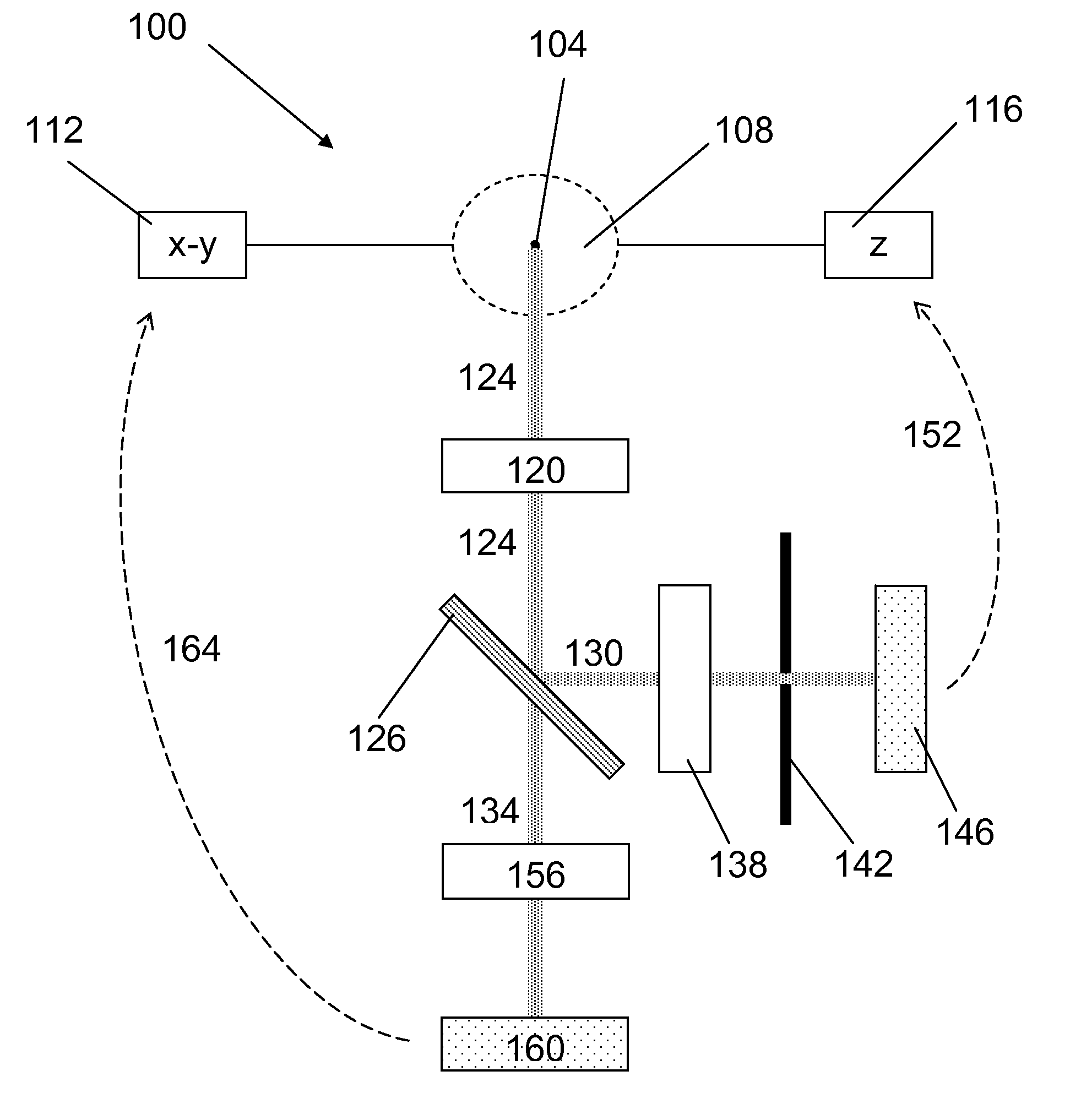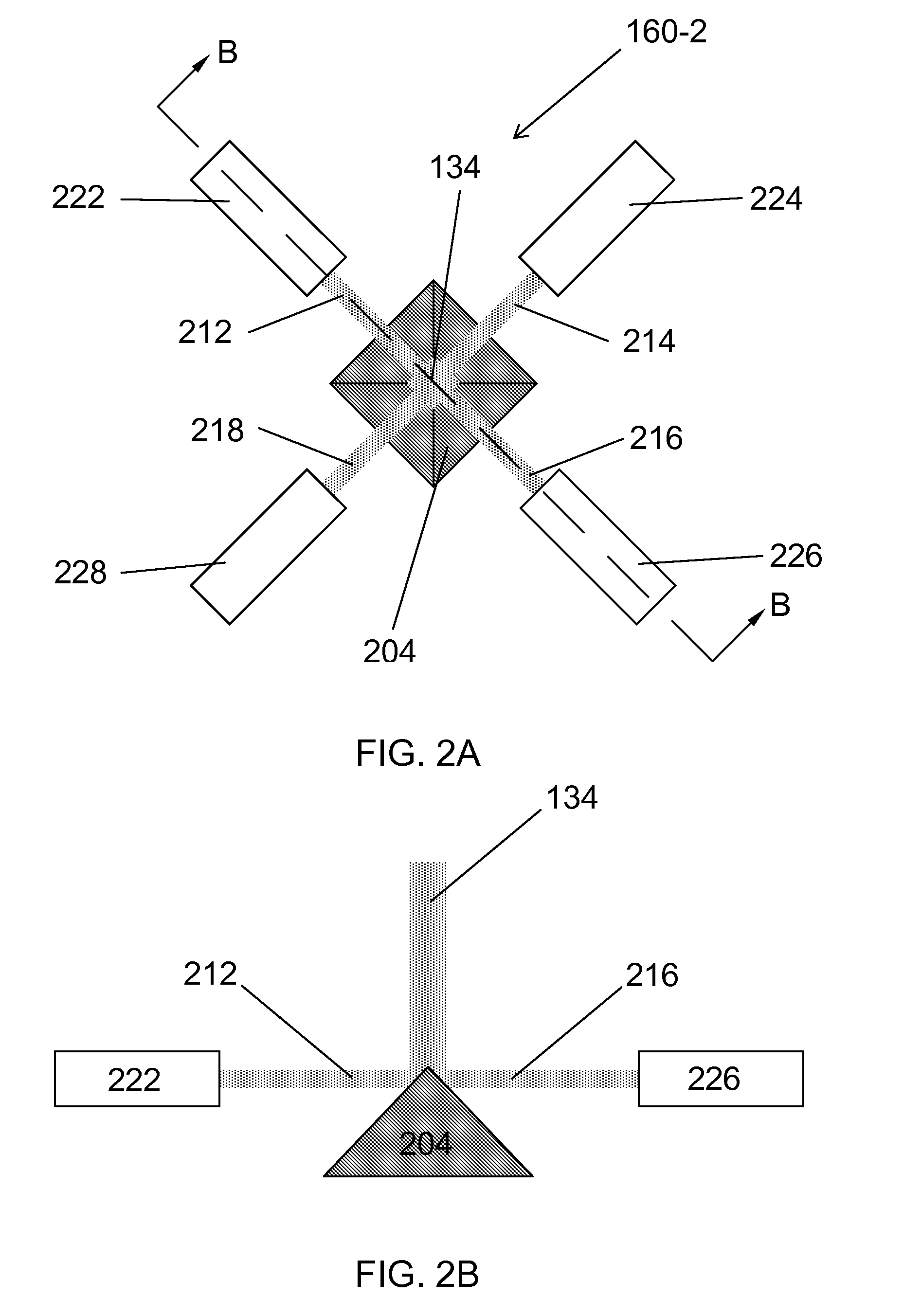[0010]Unlike active
trapping approaches, the method disclosed herein is noninvasive and provides nanometer spatial resolution with sub-
millisecond response time. In one arrangement, near-
infrared (NIR) light scattered off a gold
nanoparticle, to which a particle of interest can be tethered, provides a feedback
signal that can be used for tracking. In other arrangements,
fluorescence or
photoluminescence from a single particle of interest can be tracked without using gold nanoparticles. An
NIR light source has many advantages over a visible
light source: photo-
luminescence of the
host material is reduced,
depth of penetration is greater, especially when working with turbid samples, photo-damage of biological samples is minimized, and separation from the usual near-UV or visible excitation light used for SMS is easily achieved by
spectral filtering.
[0016]Along the path 134, a third
radiation-gathering component 156 directs the
radiation 134 onto a position-sensitive
radiation detector 160. The radiation
detector 160 is of a type suitable for detecting the radiation 134. Examples of radiation detectors have been given above. A second
feedback control mechanism 164 provides communication from the
detector 160 to the x-y control 112. The
feedback control mechanism 164 provides information to the x-y control 112 about movement of the particle 104 in the x direction and in the y direction so that the x-y control 112 can adjust the position of the particle 104 in the x direction and in the y direction as desired. The x-y control 112 moves the particle-holding device 108 to counteract the movement of the particle in the x-y plane so the position of the particle in the x-y plane is stable. In some arrangements, the
particle stability in the x or y direction is within ±50 nm. In some arrangements, the
particle stability in the x or y direction is within ±30 nm. In some arrangements, the
particle stability in the x or y direction is within ±15 nm. In other arrangements, the particle stability in the x or y direction is within ±5 nm.
[0024]Some particles or molecules can be difficult to track because they do not offer much contrast against background. To increase contrast and make tracking easier, a molecule of interest can be tethered to a metallic
nanoparticle. Light scattered from the nanoparticle is collected by the tracking objective, and the intensity of the collected light is used in feedback loops (for the particle
tracking system) to keep the particle in the
focal volume. It is still possible to perform SMS on the tethered molecule as
fluorescence photons can be collected by the SMS objective from which single molecule
time trajectory and
spectral properties can be acquired.
[0025]The use of a metallic nanoparticle as a tracer has several advantages. The small size of the nanoparticle, on the order of 40 nm or less, provides a non-obstructive biological
label to cellular processes when attached to a
biological macromolecule.
Scattered light from a 60-nm gold particle may be equivalent to up to 3×105 times greater than the light emitted by a standard fluorescent dye, or by molecular fluoresce, depending on the
wavelength used. A
signal of this intensity is very useful in the particle
tracking system. Furthermore, nanoparticles do not suffer from blinking or
photobleaching, which can occur with fluorescent labels. Detected light from
gold particles results from scattering, so it is possible to choose an illumination source, such as a
laser in the near
infrared region, that is biologically benign. The choice of an illumination source when using fluorescent labels is less flexible due to restrictions in excitation wavelengths. The
wavelength of the tracking radiation can be chosen to avoid interference with SMS, if that is used in the system.
[0030]A single molecule
spectroscopy (SMS) system 605 is similar to the design used in standard
confocal SMS configurations.
Fluorescence signals as stimulated by excitation light and focused down to a
diffraction-limited spot are collected from the
focal volume and focused through a pinhole onto a sensitive
photon detector such as an
avalanche photodiode, after passing through an emission filter. The pinhole can suppress background so that emission from a single molecule is easier to observe. Because of the single particle
tracking system, the target particle remains in focus even as it moves in three dimensions, thus making it possible to perform this kind of SMS investigation. For the spectroscopic probe, a 532-nm
laser beam 618 from a
solid-state
laser (included within the SMS system 605 in FIG. 6) is coupled into the back aperture of the objective lens 630 through a long-pass dichroic mirror 632. The objective lens 630 focuses the light at the sample 622. A second, short-pass dichroic mirror 637 can separate the NIR tracking light 613 from the optical output of the green interrogation beam (i.e., the
fluorescence signal from the sample 622. The optical output is focused by a 180-mm tube lens 640 in the
microscope and detected by an APD 647.
 Login to View More
Login to View More  Login to View More
Login to View More 


